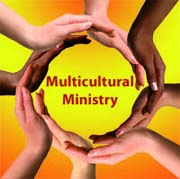Beginning Your Multicultural Ministry
 Multicultural Ministry requires self-examination. It starts by understanding who you are and moves on to looking outward.
Multicultural Ministry requires self-examination. It starts by understanding who you are and moves on to looking outward.
Start by defining your own congregation. What cultures are already present? What talents, resources and experiences can they bring to your outreach ministry?
When you’ve answered these questions, begin to look outside your church community.
Define Your Neighborhood
The word “multicultural” can mean many things.
- It can include subcultures of American Society — any number of ethnic groups and racial identities.
- It also includes social status — working class, students, divorced, public or private school youth, aged, homeless, wealthy, disabled, etc.
- It can include gender and sexual identity
- It can be generational: Boomers, Generation X, etc.
- It includes immigrants and natives.
All of these have their own “culture.”
Your congregation must define what it means in your community.
Here are some questions to consider:
- What cultures are present in your neighborhood?
- Which live in closest proximity to your building.
- Which are well established? Which are newcomers?
- Which groups are transient? (Students, seasonal workers, snowbirds or summer residents)
- What are their needs?
- Is Christianity part of their culture or is the “Good News” brand new?
- What languages do they speak? Are they also proficient in English? Will you have to find leadership to facilitate communication?
- What are their cultural expectations? Dress, food, interaction.
Consider the Cultural Expectations of the Groups You Hope to Reach
The last item on the above list of questions may be the most important and hardest to implement if you want to create a “welcome space.”
Dress in some cultures is dictated. In America, we’ve adopted a “come as you are” dress code. If your congregation expects to welcome people from the community who come from a more formal culture, you may as a group have to consider “dress.”
For example:
One family made a project of welcoming foreign students into their home. They hosted several before they ran into difficulty with a male student from an Arab country. They just weren’t connecting. They voiced their concerns to a friend who had spent time in Arab countries. The friend pointed out that the problem was partly how the females in the family dressed. “Your spaghetti-strapped tank tops are fine in America,” she told her. “But to your guest, you are naked. He will not be comfortable in your home as long as you dress that way.”
Food can unite or divide. If your neighborhood hopes to minister to Asian communities, it may have to make sure rice is a staple at your pot luck dinners. Pork and bacon can also cause problems.
If your congregation is serious about multicultural ministry, you may have to change congregational customs. Dismissing children from worship may not be an attractive option to newcomers and will create a separation among your youngest members which could take time to overcome.
Allow people to choose their seating. Some cultures divide men and women. Many will want to observe from a distance as they become comfortable. Don’t rope off seats to force people to sit closely. Let them create their own space.
Plan on Evaluating Your Progress Often
There is a lot to consider. Take the time to think things through and reconsider frequently — weekly if necessary — as you learn about one another. Mixing cultures means being willing to adapt and correct the inevitable faux pas. When you make mistakes, correct them quickly. It can be humbling — but isn’t that part of being Christian!
Network to Find Help
In your Social Media Ministry, consider all these things and create content which addresses the concerns of the cultures in your community. Your congregational blog and web site should address the topics which arise from your answers to the above questions. Create content that the various cultural groups in your neighborhood will find and follow.
Look for help. Identify agencies which serve the groups in your communities. Study their web sites. Introduce yourself. Invite them to meet with your leaders. Link to their sites. They will probably be very happy to work with you.
Be hospitable. Offer space to operate a program — such as an after-school program or a well baby clinic.
Multicultural Outreach will soon give your congregation a plan. Follow it!

[…] on November 9, 2011 by 2×2 […]